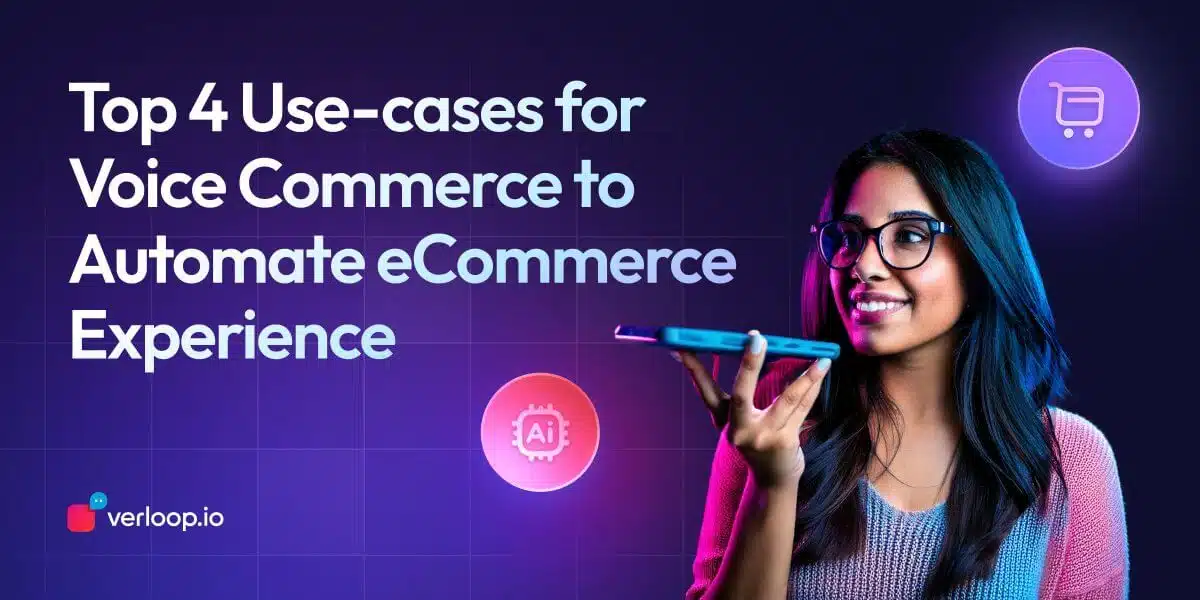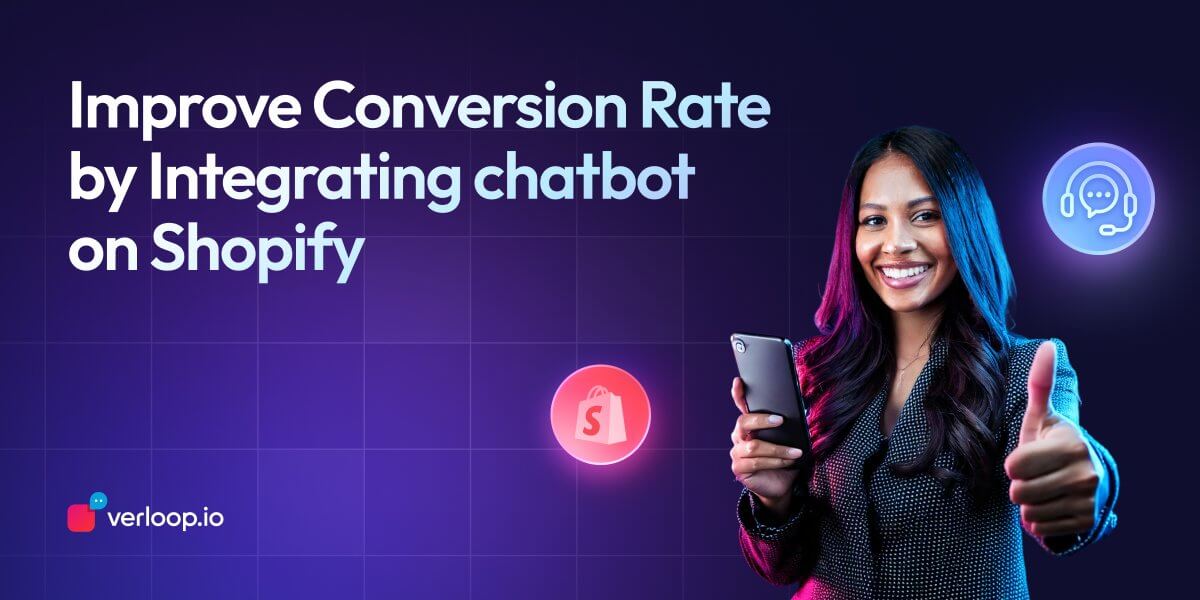
Top 4 Use-cases for Voice Commerce to Automate eCommerce Experience
- March 24th, 2025 / 5 Mins read
-
 Aarti Nair
Aarti Nair
From assisting customers with orders to handling returns and FAQs, AI-powered voice automation is transforming customer interactions. Read now!
It’s 11 PM, and Rahul just realised he hasn’t bought a birthday gift for his sister. She had mentioned wanting a customised dress, but with the store closed for the day, he assumed he’d missed his chance. On a whim, he calls XYZ Couture Store, and instead of a voicemail, an AI Agent answers.
“Hi Rahul, how can I assist you today?”
He describes the dress his sister wants—fabric, colour, size, and embroidery details. The AI Agent confirms the design, processes the order, and even schedules a delivery date. Within minutes, Rahul has successfully placed a fully customised order, all without waiting for the store to reopen.
This is the power of voice commerce. With voice commerce transactions soaring from $4.6 billion in 2021 to $19.4 billion in 2023, and projections hitting $40 billion by the end of 2024, businesses that integrate voice automation are staying ahead of the curve. In fact, 74% of consumers now use voice assistants for at least part of their retail buying process.
According to a Gartner study, 70% of white-collar workers will interact with conversational platforms on a daily basis by this year. This isn’t really surprising. Consumer expectations are changing, and today’s shopper expects speed, convenience, and personalisation across channels. For the retail sector, conversational AI like eCommerce voicebots is a powerful way to deliver this.
Know the basics:
What is AI Voice Commerce?
AI voice commerce refers to the use of voice-enabled artificial intelligence to facilitate shopping experiences, allowing customers to search for products, place orders, track deliveries, and even process returns—simply by speaking to a voice assistant or AI-powered voicebot.
Instead of clicking through multiple pages or waiting for a customer service representative, users can interact with AI agents that understand natural language and respond instantly, making shopping more seamless and efficient.
How Does AI Voice Commerce Work?
AI voice commerce operates through voice assistants—software programs designed to understand and respond to spoken commands. These assistants leverage Natural Language Processing (NLP) and Machine Learning (ML) to interpret what users say, determine intent, and perform appropriate actions.
At its core, NLP helps voice assistants understand human language, while AI and ML continuously learn from interactions to enhance responses over time. But AI voice commerce goes beyond just understanding words—it recognises intent, personalises interactions, and even adapts responses based on customer personas.
The Three Pillars of AI Voice Commerce
1. Understanding Customer Intent with NLP
In the context of voice commerce, NLP plays a crucial role in identifying customer intent and guiding them through the shopping journey.
For example, if a customer says:
🔹 “I need a new dress for a wedding”: The AI voice assistant understands the user’s intent to shop and directs them to the appropriate product category.
🔹 “Order the same sneakers I bought last time”: The system retrieves past purchase history to make reordering seamless.
🔹 “I want to return my jacket”: The assistant identifies a post-purchase request and processes the return instantly.
By leveraging NLP, AI-powered voice assistants eliminate friction in the buying process, making shopping faster, easier, and more conversational.
2. Personalised Shopping with Generative AI
Beyond NLP, AI voice commerce relies on Generative AI (Gen AI) to enhance customer interactions by offering context-aware responses and personalised recommendations.
Gen AI enables voicebots to:
✅ Remember past interactions: “Would you like to reorder the same dress in a different colour?”
✅ Offer dynamic recommendations: “Based on your style preferences, I suggest this evening gown.”
✅ Handle open-ended conversations: “What’s the best outfit for a summer wedding?”
Unlike traditional chatbots, Gen AI-powered voicebots don’t just follow scripted responses—they generate unique, human-like replies that adapt to individual shopping preferences.
For instance, if a frequent shopper at XYZ Couture Store calls in, the AI agent might say:
“Welcome back, Priya! Are you looking for a new evening gown, or would you like to check out our latest embroidered sarees?”
This level of contextual personalisation boosts customer engagement and loyalty.
3. Creating AI Voice Personas with Verloop.io
To cater to different customer demographics and engagement styles, businesses can create custom AI voice personas using platforms like Verloop.io’s Conversational AI.
With Verloop.io, you can:
🎙️ Select Prebuilt AI Voice Agents: Choose a speech profile that matches your brand’s tone—formal, casual, warm, or professional.
🤖 Customise Responses: Tailor conversations to resonate with different customer segments.
🛍️ Build Persona-Specific AI Agents: For example, a friendly, engaging AI for fashion shoppers and a precise, efficiency-driven AI for tech support.
For instance, a luxury fashion retailer may opt for a sophisticated and elegant voice persona, while an eCommerce grocery store might use a cheerful, energetic tone to keep interactions engaging.
By integrating custom AI voice agents, businesses ensure that every customer conversation feels natural, relevant, and personalised.
Top 4 use cases of an eCommerce voicebot for thriving businesses
Studies show that 51 per cent of consumers say a business needs to be available 24/7. With voicebots, their needs can be catered to efficiently and promptly.
A voicebot is equipped with AI technologies like ASR and NLP to understand what is it precisely a user needs at any hour of the day. With higher user intent and context understanding, a voicebot can swiftly either provide relevant solutions or hand over chats to available live agents.
So, what are some of the top use-cases and functions you can automate with a voicebot in your eCommerce business?
1. Answer FAQs related to order status, refunds, returns
Most eCommerce businesses deal with frequent order-related questions. “Where is my order?” is the most common, making up about 40% of all customer support queries. More often than not, eCommerce users are also worried about their stuck payments, failed transactions, refunds, exchanges, returns etc. All types of incoming eCommerce FAQs, you name it – and voicebots can handle them with ease, saving precious time and resources.
Among the other issues, eCommerce use voicebots for store locations, explaining product features, and identity verification procedures. Each of the user journeys for these use cases can be handled by a voicebot.
2. Avail product discovery at scale
I think we all agree that most eCommerce websites are cluttered with hundreds and thousands of products shelved into lengthy, and often confusing categories.
Imagine a user wanting to buy formal red leather shoes but when they visit your website, they need to scourge through Men’s fashion>Shoes>Formal shoes>Formal leather shoes and then finally formal red leather shoes. (PHEW!)
It’s incredibly daunting!
With an eCommerce voicebot, you can reduce the product discovery time by less than half and avail filtered options to your users effortlessly.
3. Bill and collect payments swiftly
You might not know it, but a big chunk of cart abandonments probably occur at your website’s checkout page. The thing is, when the user is about to convert and is at the very last stage of their buyer journey – things ARE critical.
A single inconvenience can be one too many for a user who is impatient and wants to complete their purchase ASAP. One roadblock, and whoosh – they are on to a rival website. In fact, in 2021, almost 80% of online shopping orders were abandoned.
Use-case in question: Fast payment collection reduces cart drop-offs
Your voicebot can trigger a workflow every time a user abandons a cart. It can send mobile push notifications and give a call to the user requesting them to explain the hold-up to offer the best solution to it. Now, if a customer abandoned a cart because they weren’t sure how to make the payment, the voicebot will quickly decode the user intent and walk the user through the various payment options available. It can then follow up by sending a payment gateway link to the user.
Related readings:
- Accept Payments On The Go With Verloop.io And Razorpay Integration
- Supercharge your Chatbot Conversations with These eCommerce Integrations
4. Scale strategically with constructive criticism
In a market as competitive as eCommerce, in which users are smothered with choices at their disposal, the only way to grow is by…listening.
Feedback is pivotal. Possibly more in an industry like eCommerce where customer testimonials, feedback, and reviews often make or break a deal.
Listen to your users through a voicebot that can work to timely collate user experiences over a course of time. AI’s smart analytics can help you visualise and measure the aftermath of experiences you render through metrics like CSAT, resolution rate, FRT, ART, etc.
Track and read between evolving user behaviour, demand spikes and lows, most commonly occurring hitches, and buyer process gaps to build a strategically sound future.
How do AI voice bots help you build and nurture customer relationships?
Let’s take a deeper dive into some ways that voice bots can enhance the consumer experience in retail.
When it comes to customer support, speech is the quickest way to resolve issues. With automated scripts and flows, Voice AI can increase customer satisfaction without losing time.
At other times, AI Voicebot can make self-service interactions quicker. This helps to deliver the interactions that customers demand. They can reach the answers that they need in as few iterations as possible. Multiple integrations also mean speed and convenience, as consumers need not explain their issues at every point of contact.
ML-driven AI voicebots can increase personalisation through tailored recommendations. Customers can be seamlessly directed toward products they have an affinity for. Harnessing customer data further equips retailers to handle future interactions.
Voicebots also provide omnichannel experiences across buyer touchpoints. Retailers are waking up to the power of an omnichannel strategy: a PWC study found that the number of companies investing in the omnichannel experience has jumped from 20% to more than 80% since 2020. With voicebots, they can offer a consistent experience across eCommerce contact centres, email, customer-facing websites, social media, apps, and even in-store interactions.
As we’ve seen, voice technology for retail is quick, efficient, and consistent. The effect of this on the consumer is to create and build strong relationships and brand loyalty.
Verloop.io – The voice AI Agent for your eCommerce store needs for happier, more satisfied customers
AI Voicebots today are built and used as competitive advantages in big-rush markets like eCommerce.
Voice by Verloop.io is trained on state-of-the-art automatic speech recognition (ASR) and natural language processing (NLP) to present you with a simple-to-deploy yet electrifying voicebot that’s the quickest way to reach your customers’ hearts!
To find out more about how to use voice technology for retail to create a delightful, forward-facing experience, do get in touch with us.

FAQs
-
How does AI-powered voice automation improve customer experience in eCommerce?
AI-powered voice automation enhances customer experience by providing instant responses, personalised recommendations, and seamless transaction processing. Voicebots powered by NLP and AI can understand intent, retrieve past interactions, and handle queries like order tracking, returns, and product discovery, all through natural conversation. -
Can AI voicebots handle complex customer requests like refunds and exchanges?
Yes, AI voicebots can efficiently process refunds and exchanges by verifying order details, guiding customers through return policies, and initiating the necessary workflows. With integrations into eCommerce platforms, they can automate these processes, reducing wait times and improving customer satisfaction. -
What role does Generative AI play in voice commerce?
Generative AI (Gen AI) enhances voice commerce by enabling more natural, context-aware conversations. It helps voice assistants provide personalised recommendations, remember past interactions, and respond dynamically instead of relying on pre-scripted responses. This ensures customers receive a conversational and engaging experience tailored to their preferences. -
How do AI speech profiles enhance customer interactions?
AI speech profiles allow businesses to customise the voice and tone of their AI agents to match their brand personality. Platforms like Verloop.io offer prebuilt AI voice agents with different speech styles—formal, casual, warm, or professional—so businesses can create distinct personas that resonate with their audience and provide a more natural conversational experience. -
Can voice AI help reduce cart abandonment?
Absolutely! AI-powered voicebots can engage customers in real-time when they abandon a cart, identifying concerns and offering solutions. They can send payment reminders, suggest alternative products, and even provide one-click checkout options, helping recover lost sales and improving conversion rates.







